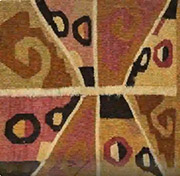Center, Textile Research

IX Jornadas Internacionales de Textiles Precolombinos y Amerindianos / 9th International Conference on PreColumbian and Amerindian Textiles, Museo delle Culture, Milan, 2022
Date of this Version
2024
Document Type
Article
Citation
Published in IX Jornadas Internacionales de Textiles Precolombinos y Amerindianos / 9th International Conference on Pre-Columbian and Amerindian Textiles, Museo delle Culture, Milan, 2022. (Lincoln, Nebraska: Zea Books, 2024)
DOI: 10.32873/unl.dc.zea.1622
Abstract
Este estudio iconográfico e iconológico se propone analizar la representación de una particular tipología de seres antropo-zoomorfos en la cultura Tiwanaku mediante una investigación transdisciplinaria, que incluye estudios de arqueología, antropología, semiótica y estética. Algunos seres antropo-zoomorfos con atributos de aves, felinos, cérvidos y llamas estarían representados flotando en sentido horizontal, y simbolizarían el chamán en su estado de trance, realizando su viaje mágico, a través del consumo de unas substancias psicoactivas. Los artistas tiwanakotas por medio de las imágenes de “seres voladores” reflejarían unos principios acerca de su cosmovisión, y revelarían el rol fundamental que algunas experiencias mágicos-religiosas ejercían en esta sociedad. Se analizarán en particular imágenes tejidas en indumentaria ceremonial comparándolas con unas representaciones pintadas en instrumentos rituales cerámicos y otras incisas en unas litoesculturas. Las representaciones del vuelo chamánico figuradas en estos elementos rituales les atribuirían un alto valor sagrado, mostrando la capacidad de algunos personajes de transitar en diferentes mundos, mediando entre hombres y dioses. La importancia de estos seres se demostraría a través de la utilización de un conjunto de símbolos de poder que seguían unas normas artístico-sagradas precisas.
This iconographic and iconological study aims to analyse the representation of a particular type of anthropo-zoomorphic beings in the Tiwanaku culture through transdisciplinary research, which includes studies of archaeology, anthropology, semiotics, and aesthetics. Some anthropo-zoomorphic beings with attributes of birds, felines, cervids and llamas would be represented floating horizontally, and would symbolize the shaman in its trance state, making its magical journey, through the consumption of some psychoactive substances. Tiwanaku artists through the images of “flying beings” would reflect some principles about their worldview and reveal the fundamental role that some magical-religious experiences played in this society. In particular, images woven in ceremonial clothing will be analysed by comparing them with representations painted in ceramic ritual instruments and other incises in litho-sculptures. The depictions of shamanic flight contained in these ritual elements would attribute to them a high sacred value, showing the ability of some characters to transit in different worlds, mediating between men and gods. The importance of these beings would be demonstrated through the use of a set of symbols of power that followed precise artistic-sacred norms.
Included in
American Material Culture Commons, Art and Materials Conservation Commons, Fiber, Textile, and Weaving Arts Commons, Indigenous Studies Commons, Latin American History Commons, Museum Studies Commons, Native American Studies Commons, Other History of Art, Architecture, and Archaeology Commons, Other Religion Commons


Comments
Copyright © 2024 Elisa Cont.